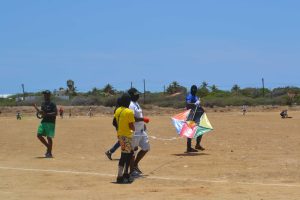(Oranjestad)—Every year for King’s Day, Arubans gather with friends and family to fly kites. Big or small, paper or plastic, blue skies fill up with these colorful flying contraptions, brightening our yearly celebration of the Dutch Monarch.
The tradition of flying kites starts at home in the weeks leading up to King’s Day. These kites were traditionally made with things found in the nearby mondi* and in the kitchen at home. Using dried up cactus sticks for the frame, old news papers, and glue made from flour, water and salt to dry faster (some people even use cornstarch slurry as glue), kids usually make their own kites with their friends, parents or other close family members. Tails are made from old bed sheets, ripped and tied together to create a long string of fabric trailing behind the back end of the kite. To finish off the process, people used fish lines or thin rope to tie three corners of the kite together. Another long string of rope is tied in the knotted center and bundled up, used to steer the kite as it flies in the air. Decorating the kite was especially important, and children would use paint to create their own designs—the more colorful, the better!

People usually fly their kites in big open fields, like empty soccer and baseball fields found all around the island around noon, when the sun is at its brightest.
In the past few years, kite flying has become a sport in which groups of people would battle against each other to see whose kite is the biggest, the prettiest, and whose could fly flawlessly and longer in the air. For this year’s celebration, Centro di Bario Playa Pabao located in Madiki is organizing another edition of their kite flying event with different categories of height starting at 8AM.

Gather your family and be a part of this colorful Aruban tradition in celebration of our King Willem-Alexander’s birthday!
*Mondi: Aruban woods.




















